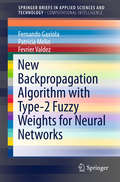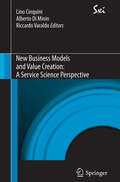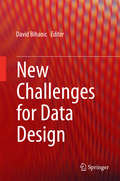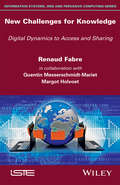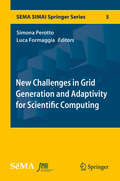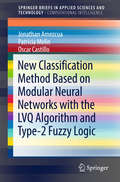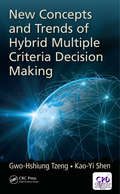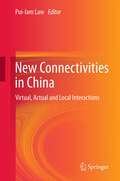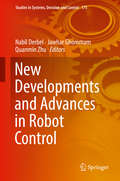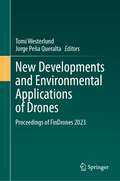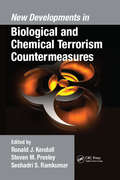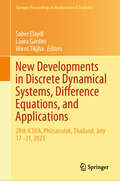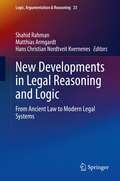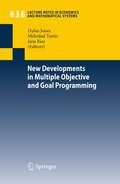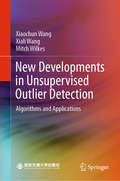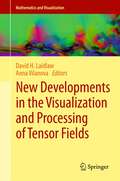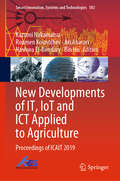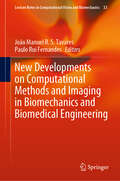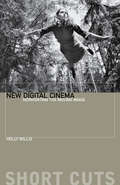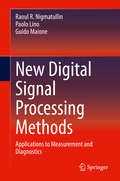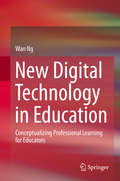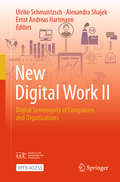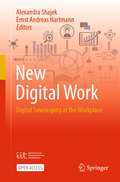- Table View
- List View
New Backpropagation Algorithm with Type-2 Fuzzy Weights for Neural Networks
by Patricia Melin Fernando Gaxiola Fevrier ValdezIn this book a neural network learning method with type-2 fuzzy weight adjustment is proposed. The mathematical analysis of the proposed learning method architecture and the adaptation of type-2 fuzzy weights are presented. The proposed method is based on research of recent methods that handle weight adaptation and especially fuzzy weights. The internal operation of the neuron is changed to work with two internal calculations for the activation function to obtain two results as outputs of the proposed method. Simulation results and a comparative study among monolithic neural networks, neural network with type-1 fuzzy weights and neural network with type-2 fuzzy weights are presented to illustrate the advantages of the proposed method. The proposed approach is based on recent methods that handle adaptation of weights using fuzzy logic of type-1 and type-2. The proposed approach is applied to a cases of prediction for the Mackey-Glass (for ô=17) and Dow-Jones time series, and recognition of person with iris biometric measure. In some experiments, noise was applied in different levels to the test data of the Mackey-Glass time series for showing that the type-2 fuzzy backpropagation approach obtains better behavior and tolerance to noise than the other methods. The optimization algorithms that were used are the genetic algorithm and the particle swarm optimization algorithm and the purpose of applying these methods was to find the optimal type-2 fuzzy inference systems for the neural network with type-2 fuzzy weights that permit to obtain the lowest prediction error.
New Business Models and Value Creation: A Service Science Perspective
by Alberto Di Minin Riccardo Varaldo Lino CinquiniThe contemporary economic landscape features the prevalence of the service sector in economic systems, the pervasive servitisation of manufacturing, innovations in traditional business models and new value creation models, thanks to the new possibilities offered by the web, ICT and other enabling technologies. In this evolving context, this book provides qualified contributions on the topic of service science from a managerial perspective. A multidisciplinary perspective is adopted, dealing with both the structural-technological and dynamic-relational aspects of managing complexity. In addressing the contribution that service science can make to business value creation, this book covers relevant issues such as product servitisation, business modelling, value cocreation with customers, performance measures and the role of ICT. It also presents some innovative experiences of management models in service organisations operating in the environmental, energy and health-care sectors. This book aims to enhance the value of the results of research intertwined with the development of a new training curriculum started four years ago at the Scuola Superiore Sant'Anna of Pisa (Italy) with the evolution of the "Master in Management of Innovation" into the new "Master in Management, Innovation and Service Engineering" (MAINS).
New Challenges for Data Design
by David BihanicThe present work provides a platform for leading Data designers whose vision and creativity help us to anticipate major changes occurring in the Data Design field, and pre-empt the future. Each of them strives to provide new answers to the question, "What challenges await Data Design?" To avoid falling into too narrow a mind-set, each works hard to elucidate the breadth of Data Design today and to demonstrate its widespread application across a variety of business sectors. With end users in mind, designer-contributors bring to light the myriad of purposes for which the field was originally intended, forging the bond even further between Data Design and the aims and intentions of those who contribute to it. The first seven parts of the book outline the scope of Data Design, and presents a line-up of "viewpoints" that highlight this discipline's main topics, and offers an in-depth look into practices boasting both foresight and imagination. The eighth and final part features a series of interviews with Data designers and artists whose methods embody originality and marked singularity. As a result, a number of enlightening concepts and bright ideas unfold within the confines of this book to help dispel the thick fog around this new and still relatively unknown discipline. A plethora of equally eye-opening and edifying new terms, words, and key expressions also unfurl. Informing, influencing, and inspiring are just a few of the buzz words belonging to an initiative that is, first and foremost, a creative one, not to mention the possibility to discern the ever-changing and naturally complex nature of today's datasphere. Providing an invaluable and cutting-edge resource for design researchers, this work is also intended for students, professionals and practitioners involved in Data Design, Interaction Design, Digital & Media Design, Data & Information Visualization, Computer Science and Engineering.
New Challenges for Knowledge: Digital Dynamics to Access and Sharing
by Margot Holvoet Quentin Messerschmidt-Mariet Renaud FabreDigital technologies are reshaping every field of social and economic lives, so do they in the world of scientific knowledge. "The New Challenges of Knowledge" aims at understanding how the new digital technologies alter the production, diffusion and valorization of knowledge. We propose to give an insight into the economical, geopolitical and political stakes of numeric in knowledge in different countries. Law is at the center of this evolution, especially in the case of national and international confusion about Internet, Science and knowledge.
New Challenges in Grid Generation and Adaptivity for Scientific Computing
by Simona Perotto Luca FormaggiaThis volume collects selected contributions from the "Fourth Tetrahedron Workshop on Grid Generation for Numerical Computations", which was held in Verbania, Italy in July 2013. The previous editions of this Workshop were hosted by the Weierstrass Institute in Berlin (2005), by INRIA Rocquencourt in Paris (2007), and by Swansea University (2010). This book covers different, though related, aspects of the field: the generation of quality grids for complex three-dimensional geometries; parallel mesh generation algorithms; mesh adaptation, including both theoretical and implementation aspects; grid generation and adaptation on surfaces - all with an interesting mix of numerical analysis, computer science and strongly application-oriented problems.
New Classification Method Based on Modular Neural Networks with the LVQ Algorithm and Type-2 Fuzzy Logic (SpringerBriefs in Applied Sciences and Technology)
by Oscar Castillo Patricia Melin Jonathan AmezcuaIn this book a new model for data classification was developed. This new model is based on the competitive neural network Learning Vector Quantization (LVQ) and type-2 fuzzy logic. This computational model consists of the hybridization of the aforementioned techniques, using a fuzzy logic system within the competitive layer of the LVQ network to determine the shortest distance between a centroid and an input vector. This new model is based on a modular LVQ architecture to further improve its performance on complex classification problems. It also implements a data-similarity process for preprocessing the datasets, in order to build dynamic architectures, having the classes with the highest degree of similarity in different modules. Some architectures were developed in order to work mainly with two datasets, an arrhythmia dataset (using ECG signals) for classifying 15 different types of arrhythmias, and a satellite images segments dataset used for classifying six different types of soil. Both datasets show interesting features that makes them interesting for testing new classification methods.
New Concepts and Trends of Hybrid Multiple Criteria Decision Making
by Gwo-Hshiung Tzeng Kao-Yi ShenWhen people or computers need to make a decision, typically multiple conflicting criteria need to be evaluated; for example, when we buy a car, we need to consider safety, cost and comfort. Multiple criteria decision making (MCDM) has been researched for decades. Now as the rising trend of big-data analytics in supporting decision making, MCDM can be more powerful when combined with state-of-the-art analytics and machine learning. In this book, the authors introduce a new framework of MCDM, which can lead to more accurate decision making. Several real-world cases will be included to illustrate the new hybrid approaches.
New Connectivities in China
by Pui-Lam LawThe fast diffusion of information and communication technologies (ICTs) in China has brought forth new forms of connection among the Chinese and has changed their social lives. Virtual networks have been developed and in turn have led to the formation of networks in the actual world. This collection explores the resultant complications in the relationship between virtual, actual, and local interactions. It discusses various aspects of the implications of the new connectivities on these three types of interactions in China. The topics examined include: the possibility of the development of civil society in China, the implications for the migrant workers in the south, the challenge posed to the traditional social order, and the relationship between the new connectivities and the Chinese social context.
New Consumer Behavior Theories from Japan (Advances in Japanese Business and Economics #27)
by Akira ShimizuThis book focuses on a new type of inclusive consumer decision-making process model (CDM) related to new leading-edge consumers. There have been two main types of CDMs for consumer behavior: one is the stimulus–response model and the other is the information-processing model. The stimulus–response model is applicable when consumers buy low-involvement products, and the information-processing model applies for high-involvement products. Thus consumers’ decision making depends on the involvement level for the products. With the advent of the widespread use of the Internet, however, the situation has changed. Consumers whose information sensitivity is high (i.e., among leading-edge consumers) now use the Internet to search for information even for low-involvement products. The consumers’ decision-making process depends therefore on their information sensitivity, not on the involvement level of the products. Also, these leading-edge consumers become in effect another type of media as they broaden their experience through the Internet. Under these circumstances, research about leading-edge consumers and the introduction of a new CDM is highly significant. This book gathers data about leading-edge consumers, analyzes these data, then proposes a new type of CDM called “circulation marketing”. Following this model, not only the previous types of CDM, but also the new kind of CDM, including share behavior of leading-edge consumers, is explained.
New Creep at School (Creeper Diaries #3)
by Amanda Brack Greyson MannIs a cool new creeper as friendly as he seems?Gerald is thrilled when a new creeper starts up at Mob Middle School. Finally, there'll be a mob to hang out with that isn't a bouncy slime or a flesh-eating zombie! With Connor by his side, Gerald starts his thirty-day plan to make creepers the coolest mob at school. At first, Connor does seem cool. He seems to have endless amounts of emeralds for the vending machine. He figures out a way to get Gerald on the field trip bus, even though Gerald's parents didn't exactly give permission. And he plays pranks on Bones and his bony buddies that Gerald would have never tried alone. But when Gerald's journal goes missing and his private thoughts and secret rap songs start spreading around school, Gerald wonders if Connor is behind it. He needs help solving the mystery surrounding this new mob. The only problem? Gerald's old friends are suddenly nowhere to be found. Is this creeper on his own?
New Developments and Advances in Robot Control (Studies in Systems, Decision and Control #175)
by Quanmin Zhu Nabil Derbel Jawhar GhommamThis book highlights relevant studies and applications in the area of robotics, which reflect the latest research, from interdisciplinary theoretical studies and computational algorithm development, to representative applications. It presents chapters on advanced control, such as fuzzy, neural, backstepping, sliding mode, adaptive, predictive, diagnosis and fault tolerant control etc. and addresses topics including cloud robotics, cable-driven robots, two-wheeled robots, mobile robots, swarm robots, hybrid vehicle, and drones. Each chapter employs a uniform structure: background, motivation, quantitative development (equations), case studies/illustration/tutorial (simulations, experiences, curves, tables, etc.), allowing readers to easily tailor the techniques to their own applications.
New Developments and Environmental Applications of Drones: Proceedings of FinDrones 2023
by Tomi Westerlund Jorge Peña QueraltaThis volume presents the conference proceedings from FinDrones 2023. The book highlights recent drone technology developments by experts and academicians for applications in agriculture, forestry, and other industries. This iteration of FinDrones presents research using autonomous drones in various fields from environmental monitoring to farm robotics and from photogrammetry to search and rescue missions. Emphasis is placed on contextualizing the conference presentations and content to Finland and the unique challenges typical to the region. The work will interest academicians, entrepreneurs, and professionals involved in remote sensing applications of unmanned aerial vehicles and enthusiasts of drone technological developments.
New Developments in Biological and Chemical Terrorism Countermeasures
by Ronald J. Kendall; Steven M. Presley; Seshadri S. RamkumarA science-based text, New Developments in Biological and Chemical Terrorism Countermeasures presents research that addresses the growing threat of chemical and biological terrorism as well as the need for improvements in the implementation of countermeasures. This new textbook building upon Advances in Biological and Chemical Terrorism Countermeasu
New Developments in Discrete Dynamical Systems, Difference Equations, and Applications: 28th ICDEA, Phitsanulok, Thailand, July 17-21, 2023 (Springer Proceedings in Mathematics & Statistics #485)
by Saber Elaydi Laura Gardini Wirot TikjhaThis compelling book presents remarkable contributions from esteemed speakers who participated in the 28th International Conference on Difference Equations and Applications, ICDEA 2023, hosted at Phitsanulok, Thailand, in collaboration with the International Society of Difference Equations (ISDE) from July 17 to 21, 2023. Embark on an enriching journey through the realms of difference equations and discrete dynamical systems, with practical applications spanning economics, engineering, biology, and related sciences. Immerse yourself in cutting-edge research as you explore new and significant breakthroughs within the fields of difference equations and discrete dynamical systems. This comprehensive compilation spans diverse scientific disciplines, demonstrating the profound impact of these theories and methodologies in practical and tangible settings. From economic modeling to engineering optimization, from biological systems to interdisciplinary applications, this book exemplifies the versatility and relevance of difference equations and discrete dynamical systems. Designed to resonate with a wide audience, including Ph.D. students, researchers, educators, and practitioners, it goes beyond mere dissemination of recent results. It actively fosters the advancement of knowledge, serving as a catalyst for further explorations and innovations across the spectrum of sciences.
New Developments in Legal Reasoning and Logic: From Ancient Law to Modern Legal Systems (Logic, Argumentation & Reasoning #23)
by Shahid Rahman Matthias Armgardt Hans Christian Nordtveit KvernenesThis book intends to unite studies in different fields related to the development of the relations between logic, law and legal reasoning. Combining historical and philosophical studies on legal reasoning in Civil and Common Law, and on the often neglected Arabic and Talmudic traditions of jurisprudence, this project unites these areas with recent technical developments in computer science. This combination has resulted in renewed interest in deontic logic and logic of norms that stems from the interaction between artificial intelligence and law and their applications to these areas of logic. The book also aims to motivate and launch a more intense interaction between the historical and philosophical work of Arabic, Talmudic and European jurisprudence. The publication discusses new insights in the interaction between logic and law, and more precisely the study of different answers to the question: what role does logic play in legal reasoning? Varying perspectives include that of foundational studies (such as logical principles and frameworks) to applications, and historical perspectives.
New Developments in Multiple Objective and Goal Programming
by Mehrdad Tamiz Dylan Jones Jana RiesThis volume shows the state-of-the-art in both theoretical development and application of multiple objective and goal programming. Applications from the fields of supply chain management, financial portfolio selection, financial risk management, insurance, medical imaging, sustainability, nurse scheduling, project management, water resource management, and the interface with data envelopment analysis give a good reflection of current usage. A pleasing variety of techniques are used including models with fuzzy, group-decision, stochastic, interactive, and binary aspects. Additionally, two papers from the upcoming area of multi-objective evolutionary algorithms are included. The book is based on the papers of the 8th International Conference on Multi-Objective and Goal Programming (MOPGP08) which was held in Portsmouth, UK, in September 2008.
New Developments in Unsupervised Outlier Detection: Algorithms and Applications
by Xiaochun Wang Xiali Wang Mitch WilkesThis book enriches unsupervised outlier detection research by proposing several new distance-based and density-based outlier scores in a k-nearest neighbors’ setting. The respective chapters highlight the latest developments in k-nearest neighbor-based outlier detection research and cover such topics as our present understanding of unsupervised outlier detection in general; distance-based and density-based outlier detection in particular; and the applications of the latest findings to boundary point detection and novel object detection. The book also offers a new perspective on bridging the gap between k-nearest neighbor-based outlier detection and clustering-based outlier detection, laying the groundwork for future advances in unsupervised outlier detection research.The authors hope the algorithms and applications proposed here will serve as valuable resources for outlier detection researchers for years to come.
New Developments in the Visualization and Processing of Tensor Fields
by Anna Vilanova David H. LaidlawBringing together key researchers in disciplines ranging from visualization and image processing to applications in structural mechanics, fluid dynamics, elastography, and numerical mathematics, the workshop that generated this edited volume was the third in the successful Dagstuhl series. Its aim, reflected in the quality and relevance of the papers presented, was to foster collaboration and fresh lines of inquiry in the analysis and visualization of tensor fields, which offer a concise model for numerous physical phenomena. Despite their utility, there remains a dearth of methods for studying all but the simplest ones, a shortage the workshops aim to address. Documenting the latest progress and open research questions in tensor field analysis, the chapters reflect the excitement and inspiration generated by this latest Dagstuhl workshop, held in July 2009. The topics they address range from applications of the analysis of tensor fields to purer research into their mathematical and analytical properties. They show how cooperation and the sharing of ideas and data between those engaged in pure and applied research can open new vistas in the study of tensor fields.
New Developments of IT, IoT and ICT Applied to Agriculture: Proceedings of ICAIT 2019 (Smart Innovation, Systems and Technologies #183)
by Bin Hu Kazumi Nakamatsu Roumen Kountchev Nashwa El-Bendary Ari AharariThe proceedings publishes new research results of scholars from the First International Conference on Agriculture and Information (ICAIT2019) organized by IRNet International Academic Communication Center, held during November 22-24, 2019. The book covers works from active researchers who are working on collaboration of agriculture and various information technologies such as ICT (Information and Communication Technologies) applicable/applied to agricultural produce, manufacturing preservation and distribution of agricultural products, etc. The book focuses on theory, design, development, testing and evaluation of all information technologies applicable/applied to various parts of agriculture and its infrastructure. The topics included are information technologies applicable to smart agriculture, intelligent information systems for smart farm systems, web-based intelligent information systems on agriculture, ICT-based marketing of agricultural products, agricultural product consumption network systems, IoT for agricultural produce and products, soft computing theories, intelligent management for agriculture, data science techniques for agriculture.
New Developments on Computational Methods and Imaging in Biomechanics and Biomedical Engineering (Lecture Notes in Computational Vision and Biomechanics #999)
by Paulo Rui Fernandes João Manuel R. S. TavaresThis book gathers selected, extended and revised contributions to the 15th International Symposium on Computer Methods in Biomechanics and Biomedical Engineering (CMBBE2018), and the 3rd Conference on Imaging and Visualization, which took place on 26-29 March, 2018, in Lisbon, Portugal. The respective chapters highlight cutting-edge methods, e.g. new algorithms, image analysis techniques, and multibody modeling methods; and new findings obtained by applying them in biological and/or medical contexts. Original numerical studies, Monte Carlo simulations, FEM analyses and reaction-diffusion models are described in detail, together with intriguing new applications. The book offers a timely source of information for biologists, engineers, applied mathematicians and clinical researchers working on multidisciplinary projects, and is also intended to foster closer collaboration between these groups.
New Digital Cinema: Reinventing the Moving Image (Short Cuts)
by Holly WillisThis introduction to contemporary digital cinema tracks its intersection with video art, music video, animation, print design and live club events to create an avant-garde for the new millennium. It begins by investigating digital cinema and its contribution to innovations in the feature-film format, examining animation and live-action hybrids, the gritty aesthetic of the Dogme 95 filmmakers, the explosions of frames within frames and the evolution of the ‘ambient narrative’ film. This study then looks at the creation of new genres and moving-image experiences as what we know as ‘cinema’ enters new venues and formats.
New Digital Signal Processing Methods: Applications to Measurement and Diagnostics
by Raoul R. Nigmatullin Paolo Lino Guido MaioneThis book is intended as a manual on modern advanced statistical methods for signal processing. The objectives of signal processing are the analysis, synthesis, and modification of signals measured from different natural phenomena, including engineering applications as well. Often the measured signals are affected by noise, distortion and incompleteness, and this makes it difficult to extract significant signal information. The main topic of the book is the extraction of significant information from measured data, with the aim of reducing the data size while keeping the basic information/knowledge about the peculiarities and properties of the analyzed system; to this aim, advanced and recently developed methods in signal analysis and treatment are introduced and described in depth. More in details, the book covers the following new advanced topics (and the corresponding algorithms), including detailed descriptions and discussions: the Eigen-Coordinates (ECs) method, The statistics of the fractional moments, The quantitative "universal" label (QUL) and the universal distribution function for the relative fluctuations (UDFRF), the generalized Prony spectrum, the Non-orthogonal Amplitude Frequency Analysis of the Smoothed Signals (NAFASS), the discrete geometrical invariants (DGI) serving as the common platform for quantitative comparison of different random functions. Although advanced topics are discussed in signal analysis, each subject is introduced gradually, with the use of only the necessary mathematics, and avoiding unnecessary abstractions. Each chapter presents testing and verification examples on real data for each proposed method. In comparison with other books, here it is adopted a more practical approach with numerous real case studies.
New Digital Technology in Education
by Wan NgThis book addresses the issues confronting educators in the integration of digital technologies into their teaching and their students' learning. Such issues include a skepticism of the added value of technology to educational learning outcomes, the perception of the requirement to keep up with the fast pace of technological innovation, a lack of knowledge of affordable educational digital tools and a lack of understanding of pedagogical strategies to embrace digital technologies in their teaching. This book presents theoretical perspectives of learning and teaching today's digital students with technology and propose a pragmatic and sustainable framework for teachers' professional learning to embed digital technologies into their repertoire of teaching strategies in a systematic, coherent and comfortable manner so that technology integration becomes an almost effortless pedagogy in their day-to-day teaching. The materials in this book are comprised of original and innovative contributions, including empirical data, to existing scholarship in this field. Examples of pedagogical possibilities that are both new and currently practised across a range of teaching contexts are featured.
New Digital Work II: Digital Sovereignty of Companies and Organizations
by Ernst Andreas Hartmann Alexandra Shajek Ulrike SchmuntzschThis book is an open access book. Following the edited volume ‘New Digital Work’ focusing on Digital Sovereignty at the workplace, this volume with the title ‘New Digital Work II’ provides insights into aspects of Digital Sovereignty of companies and organizations and its implications for those. It aims to broaden the views of the previous book beyond the significance of digital work for workers and their respective workplaces to companies and entire industry branches. To this end, not only common challenges concerning the Digital Sovereignty of companies and organizations but also suggestions, best practice examples, and thoughts from different academic perspectives and industry sectors are included. Various interdisciplinary contributions from computer science, economics, social sciences, HR management, organizational psychology and human factors, mechanical and industrial engineering, and law address different building blocks of Digital Sovereignty of companies and organizations.
New Digital Work: Digital Sovereignty at the Workplace
by Ernst Andreas Hartmann Alexandra ShajekThis open access book will give insights into global issues of work and work systems design from a wide range of perspectives. Topics like the impact of AI in the workplace as well as design for digital sovereignty at the workplace or foresight processes for digital work are covered. Practical cases, empirical results and theoretical considerations are not only taken from Germany and Europe, but also from Southeast Asia, South Africa, Middle America, and Australia. The book intends to expand the so far national view on the aspects of digital work (e.g. like in Ernst Hartmann’s immensely successful work “Zukunft der Arbeit in Industrie 4.0”) into an international context – thus showing not only common challenges, but also offering suggestions, best practice examples or thoughts from different global regions.
